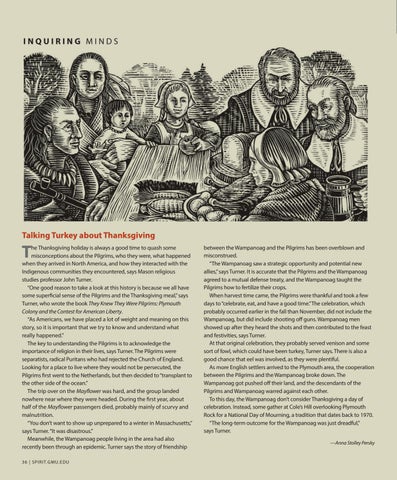GETTY IMAGES
INQUIRING MINDS
Talking Turkey about Thanksgiving
T
he Thanksgiving holiday is always a good time to quash some misconceptions about the Pilgrims, who they were, what happened when they arrived in North America, and how they interacted with the Indigenous communities they encountered, says Mason religious studies professor John Turner. “One good reason to take a look at this history is because we all have some superficial sense of the Pilgrims and the Thanksgiving meal,” says Turner, who wrote the book They Knew They Were Pilgrims: Plymouth Colony and the Contest for American Liberty. “As Americans, we have placed a lot of weight and meaning on this story, so it is important that we try to know and understand what really happened.” The key to understanding the Pilgrims is to acknowledge the importance of religion in their lives, says Turner. The Pilgrims were separatists, radical Puritans who had rejected the Church of England. Looking for a place to live where they would not be persecuted, the Pilgrims first went to the Netherlands, but then decided to “transplant to the other side of the ocean.” The trip over on the Mayflower was hard, and the group landed nowhere near where they were headed. During the first year, about half of the Mayflower passengers died, probably mainly of scurvy and malnutrition. “You don’t want to show up unprepared to a winter in Massachusetts,” says Turner. “It was disastrous.” Meanwhile, the Wampanoag people living in the area had also recently been through an epidemic. Turner says the story of friendship 36 | SPI RIT.GMU.EDU
between the Wampanoag and the Pilgrims has been overblown and misconstrued. “The Wampanoag saw a strategic opportunity and potential new allies,” says Turner. It is accurate that the Pilgrims and the Wampanoag agreed to a mutual defense treaty, and the Wampanoag taught the Pilgrims how to fertilize their crops. When harvest time came, the Pilgrims were thankful and took a few days to “celebrate, eat, and have a good time.” The celebration, which probably occurred earlier in the fall than November, did not include the Wampanoag, but did include shooting off guns. Wampanoag men showed up after they heard the shots and then contributed to the feast and festivities, says Turner. At that original celebration, they probably served venison and some sort of fowl, which could have been turkey, Turner says. There is also a good chance that eel was involved, as they were plentiful. As more English settlers arrived to the Plymouth area, the cooperation between the Pilgrims and the Wampanoag broke down. The Wampanoag got pushed off their land, and the descendants of the Pilgrims and Wampanoag warred against each other. To this day, the Wampanoag don’t consider Thanksgiving a day of celebration. Instead, some gather at Cole’s Hill overlooking Plymouth Rock for a National Day of Mourning, a tradition that dates back to 1970. “The long-term outcome for the Wampanoag was just dreadful,” says Turner. —Anna Stolley Persky









